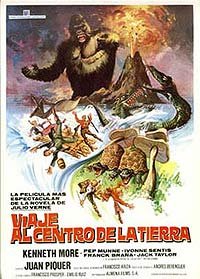Viaje al Centro de la Tierra |
      • Directed by: Juan Piquer Simón. • Starring: Kenneth More, Pep Munné, Ivonne Sentis, Frank Braña, Jack Taylor, José María Caffarel, Emiliano Redondo, Lone Fleming, Ricardo Palacios, George Rigaud, Fabián Conde, Ana del Arco, Manuel Pereiro. • Music by: Juan José García Caffi, Juan Carlos Calderón. • Directed by: Juan Piquer Simón. • Starring: Kenneth More, Pep Munné, Ivonne Sentis, Frank Braña, Jack Taylor, José María Caffarel, Emiliano Redondo, Lone Fleming, Ricardo Palacios, George Rigaud, Fabián Conde, Ana del Arco, Manuel Pereiro. • Music by: Juan José García Caffi, Juan Carlos Calderón.     Four persons try to get to the centre of the world by entering into a world of caves by a volcano. On their way they discover among other things also prehistoric animals like some dinosaurs. Four persons try to get to the centre of the world by entering into a world of caves by a volcano. On their way they discover among other things also prehistoric animals like some dinosaurs.
|
Trailers:
| Length: | Languages: | Subtitles: |
Review:










The date of the story is shifted to 1898, to make it more contemporary for the audience, in both technology and social mores (such as the place of women). In Hamburg, an aged man tries to sell several old volumes at a book store; they are bought by Lidenbrock. Arriving home, he finds the soldier Axel accidentally kneeling before his niece Glauben, and assuming there has been a marriage proposal, gladly but offhandedly offers his consent. Glauben notices the small note that falls from the book, and together Lidenbrock, Axel, and Glauben, with the help of the cinematically referential device of a magic lantern, discover the key to Saknussemm's code.
Under the same necessity to add a feminine lead as other versions, WHERE TIME BEGAN follows a vastly simpler method. Glauben wants to go on the trip, and her practicality proves a valuable assistance to the absent-minded Lidenbrock and equally ill-prepared Axel. By contrast, it is Axel who is uncertain, hesitant, and reluctant; the juxtaposition of his equivocation with Lidenbrock's certainty and Glauben's eagerness provides humor that was not in the novel.
The exteriors of the expedition's beginning and exit through craters were taken at the Lanzarote volcano in the Canary Islands, providing a barren, other-worldly appearance that almost resembles a moonscape. Although the reddish plains scarcely resembled Iceland, a series of extreme dramatic zooms impressively isolates the cast amidst the desolate location, providing a more dynamic lead-up to the descent than in the 1959 movie. The plunge into the Earth was shot a half-mile inside caves near Madrid, with the lighting effectively dark and claustrophobic.
When Hans's pickaxe thrust releases boiling water, it burns the hand of the man Glauben had seen in the darkness--who finally introduces himself as Olsen (Jack Taylor). The underground sea seems to have a healing physical power over the members of the expedition. Glauben notices that Olsen never seems to require sustenance, and his only tool is a copper-colored metal box he carries with him (which unfortunately resembles in size and shape nothing so much as a metal tea-kettle).
The sequence around the underground sea is, as in the novel, the centerpiece of the story, and the full treatment of this setting and the incidents around it--the island, the dinosaurs, the storm--with a large degree of fidelity to Verne, make WHERE TIME BEGAN noticeably different from other films of the novel. Filters turn the ocean a deep shade of greenish-blue aqua, contrasting with the orange of the land; the striking color combinations make the setting all the more convincing.
Washed ashore with the wreckage of their raft and their equipment after the storm, Axel and Glauben go in search of Olsen, passing through a field of fossils and into a forest. At this point, WHERE TIME BEGAN becomes increasingly far-fetched. Axel and Glauben are suddenly attacked, not by the ten foot prehistoric man of Verne's imagination, but by a giant ape, failing to connect with Verne's evolutionary link. Olsen comes to the rescue, and allowing them to glimpse a whole city of men who resemble him.
Olsen sets off an explosion that will open an escape for Lidenbrock, Axel, Glauben, and Hans, saying he will find his own way to safety. The scene comes rather suddenly, and is confusing in its brevity and lack of explanatory dialogue. WHERE TIME BEGAN avoids saying whether the expedition actually reached their destination or not, so there is no sense of the downward distance they have traveled.
In a coda, Axel and Glauben have married, Hans is once more a prosperous sheepherder, and Lidenbrock still haunts the old bookshop. One day, he learns that a parcel has been left for him, and, unwrapped, it proves to be Olsen's metal box. Looking toward the shop window, Lidenbrock sees an aged man, the same one who brought in Saknussemm's journal--and recognizes that he is "Olsen." This parallel closure brings the film back to where it began.
Is Olsen perhaps meant to be Arne Saknussemm himself, or a representative of his pioneering spirit? Either or both could be true; Olsen stands in for the absent predecessor whose earlier journey they are recreating. Significantly, Olsen appears after Lidenbrock loses Saknussemm's original book, and will rescue the travelers at the point where Saknussemm's last carving of his initials appears. He is less of a full-fledged character than a symbol, a vivid reminder of the theme of time that, in the form of evolution, was such a motif of the novel.
Review by briantaves from the Internet Movie Database.
Conventions & Events
Latest Teasers
Latest Trailers
Latest TV Spots